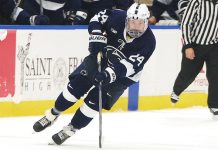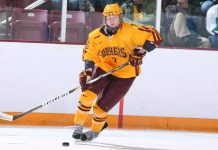The NCAA is quite pleased with its rules aimed at keeping dangerous contact out of college hockey.
But, it feels, there is always room for improvement.
So it is that a few tweaks to the current rules were recommended to the NCAA Ice Hockey Rules Committee during its annual meetings, held June 8-10.
“Our feedback from the membership,” said Niagara athletic director Ed McLaughlin, who chairs the rules committee, “was the most we’ve ever had in terms of data and comments.”
That feedback, much of which came from coaches and on-ice officials, included video examples of illegal and questionable plays, as well as statistics related to injuries and called penalties.
“I think that really helped us as a committee,” McLaughlin said. “It really helped us fine tune some things that we’ve done, to make sure our game is the best it can be. To make sure our rules are enforced properly. I was really happy with that.”
The NCAA amends its ice hockey rules every two years.
Last year, the body made 27 rules changes, which included modifications to its thresholds for dangerous contact, particularly to a player’s head.
“I like to think that we have the best rule in hockey for contact to the head,” McLaughlin said.
In 2010, language was added to that rule designed to give officials leeway to assess major penalties where targeting of an opponent’s head is suspected.
However, after one season on the books, it appeared that the term “targets” left too much room for interpretation.
“What we found,” said McLaughlin, “was that people were fixating on the targeting part, and not taking the other parts into consideration. It’s not just a targeting-the-head rule. We tried to get some good examples of defenseless and blind-side [hits], just to make sure the onus was on the [player] administering the hit. Not just the one playing the hit. Targeting is part of it, but it’s not limited to targeting.
“What we’re trying to limit is the number of games and practices lost due to concussions. The best way to look at it is after next year, when we have two years in the books to see if we’ve created any trends.”
Several other rules changes and new proposals were looked at by the panel, including those governing embellishment/diving and face shields.
The tactic of diving in order to try to draw minor penalties – a growing problem in the eyes of many coaches – will come under greater scrutiny during the 2011-12 season, with tighter rules to come if they are deemed necessary.
“We took it to the coaches,” said McLaughlin, “and they overwhelmingly felt that diving or embellishment needed to be addressed. I think it’s an important issue, because we certainly don’t want to lose the integrity of the game. I want it to be easier for the officials to call.”
As for facial protection, the sentiment is growing for jettisoning the old style wire cages and cumbersome plastic bubbles that have been in use for decades.
Instead, McLaughlin is advocating the use of a plastic half shield – which drops to below the cheekbones – that allow for better peripheral vision while still preventing many forms of injury.
“We’re going to do our due diligence this year,” he said. “Using as much information as we can. We’ll survey coaches, student-athletes, trainers. We’ll have to go in front of the Committee on Competitive Safeguards to make this presentation. I do think there is overwhelming support from the coaches and [league] commissioners to make this a possibility for our game.”
McLaughlin notes that visor technology has improved greatly in recent years.
And allowing players to use more professional style equipment will help those who will eventually move on to the pro level.
“Our hope,” McLaughlin said, “is that we can create something where we’re getting them ready to play professionally as well, in a safe way. I just think that the way the technology has changed, wearing the visor is a lot more reasonable than it was 20 years ago. It’s a lot safer than it was before.”


